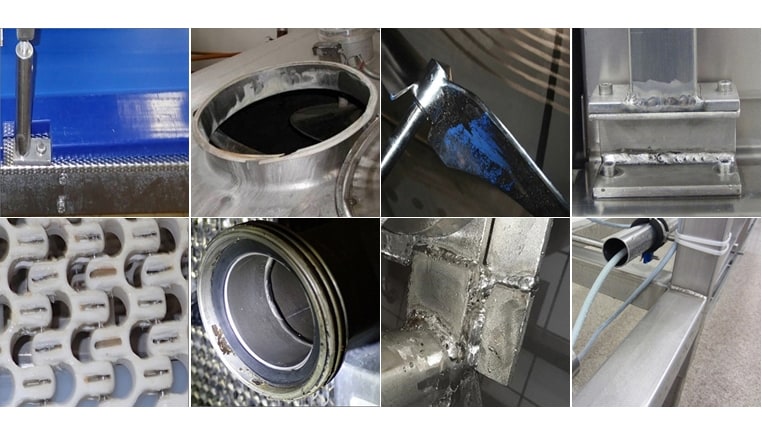Setting up Cleaning and Disinfection for Success
Essential elements to achieve your goals in hygiene outcome, product safety and operational efficiency.

You have the best possible cleaning and disinfection programs in place with well documented procedures, regular staff training, monitoring and auditing paired with world-class cleaning and disinfection chemicals and cleaning equipment. And still, you don't always succeed in your goals to produce high quality food at high cleaning efficiency at a low environmental impact? One reason for this could be in the design of your process, machinery, plant, building or your processing equipment. This is also referred to as hygienic design. Hygienic design refers to the selection of materials and application of design techniques that enable efficient and effective cleaning of production equipment and the processing environment. Good hygienic design not only minimizes the risk of product contamination, but also helps to increase operational efficiency by reducing cleaning time, water and energy consumption as well as improving the hygiene status prior to operation.
Getting to the Heart of the Matter
Temperature, contact time, type and concentration of the cleaning chemistry as well as the mechanical forces are the parameters for optimum residue removal while cleaning. These parameters are adjusted to allow efficient removal of residues. Smooth, easily accessible surfaces facilitate residue removal, while rough and hard-to-reach areas make it more difficult.
If you look at your processing equipment, however, you will notice that hygienic design might not always be optimal. In these locations, the flow conditions are often disadvantageous and access to residues is more difficult. Examples include removable pipe fittings or sensor connections on tanks or pipelines and overlapping installations. By using ready-made, contemporary cleaning solutions, more efficient and faster cleaning cycles can be achieved in these neuralgic areas, provided that they are accessible for the cleaning media at all. Contemporary cleaning solutions fulfil important functions: They are able to penetrate residues quickly (diffusion) and ensure complete wetting of surfaces and, thanks to their capillary action, enable efficient removal of residues from areas even with weaker hygienic design.
If you are spending too much time, energy or resources on cleaning and still not meeting your standards for cleanliness and hygiene, it is time to think about the interaction of cleaning products with hygienic design.
The Main Objective of Cleaning
Cleaning processes must contribute to quality and safety of food. All adjustments to the cleaning process must be aligned to this key prerequisite. Cleaning is described as a process of removing unwanted substances from surfaces that could potentially prevent the processing task from being carried out as intended. This includes the removal of food residues, but also contaminants such as microorganisms, allergens as well as physical or chemical residues.
Directives, Standards and Guidelines
In the European Union, the requirements for machines and systems used for the production of foodstuffs are regulated in the Machinery Directive 2006/42/EC. In addition, for example the 3A Sanitary Standards, or the EHEDG guidelines provide valuable guidance on the selection of materials, the design and specification of the respective hygienic requirements and the cleaning procedures.
Where Should the Focus Be?
Hygienic design covers a wide field. The EHEDG documents refers to the following six basic hygiene and design principles:
- Separation
- Cleanability
- Accessibility
- Drainage
- Surface and Geometry
These hygiene and design principles should be given special attention and represent the prerequisite for effective food processing and hygiene interventions.
- Separation of surfaces. Basically, all surfaces that food might be exposed to are relevant for consideration. This includes surfaces from which product splashes, liquids or dirt can run off, drip, diffuse or be transferred to the food.Hygienic design standards commonly divide into three risk areas: Firstly, areas in direct food contact and secondly areas above the products always pose an increased risk of contamination. Thirdly, areas to the side or below the product have a lower risk of contamination, but can lead to cross-contamination. I recommend that the different areas always be given equal priority in risk assessments.
- Cleanable to a risk-free level. Processing equipment and buildings should be designed and maintained to ensure effective and efficient cleaning during their entire lifetime. They should be designed to prevent the penetration, survival and growth of microorganisms and to allow other contaminants that may pose a risk, such as allergens, to be removed from both product-contact and non-product-contact surfaces.
- Accessible for cleaning. All surfaces must be fully accessible to the cleaning and disinfecting agents for proper inspection, maintenance, cleaning and hygiene. Equipment that is cleaned by spraying or foaming must be free of spray shadows. You should always explore ways to obtain hygiene status results of areas that cannot be directly inspected after cleaning. Ecolab offers various solutions for this, for example to identify biofilms in such neuralgic process areas.
- No accumulation of moisture. Surfaces should allow a complete run-off of water and process equipment should be self-draining. EHEDG recommends that tanks or containers with drainage openings should have bottom surfaces with a slope of more than 3° to the outlet for complete emptying. This ensures that liquid residues cannot accumulate at any point.
Ensure that your surfaces remain as dry as possible. Elements on the units should be rounded or angled to prevent the accumulation of liquids or products. Frame parts should be aligned so that water can drain away. Moisture should not drip, drain or soak into product areas. Note that water residues can lead to microbiological growth and biofilm formation, especially during longer downtimes.
- Material for constructions. All food contact surfaces should be non-absorbent but easy to clean and disinfect. All materials must allow processing equipment to be hygienically designed. In particular, the formation of surface defects should be carefully avoided both at the manufacturing stage and during maintenance. Maintenance and servicing should always be carried out professionally and at appropriate intervals (preventive maintenance!). It is also a basic requirement for the reproducibly of cleaning and disinfection that all selected materials are chemically resistant and free of corrosion.
- Surface and geometry. Surfaces and geometries can be divided into subunits. The topography of the surface in direct and indirect contact with the food product should meet all specified acceptance criteria. Surface roughness is one of the cleanability criteria in this context. No shelter or niche areas should hinder the access of a cleaning regime. A niche is a place that favors microbial growth and is not reached during the cleaning process. This may be indicated, for example, by abnormal bacterial counts after cleaning and disinfection. Niches often include cracks, corrosion, depressions, poorly made welds, overlapping joints (such as metal to metal joints), damaged gaskets, internal threads and dead ends, to name just a few. Hiding places provide growth niches for microorganisms, as food residues and moisture are also often present in these areas.
You should identify hygienically weak areas and take appropriate action after a risk evaluation. This may be the elimination of these areas, or if this is not possible, it should be incorporated into a sampling plan. Shelter or niche areas are hotspots for microbial and allergenic hazards. Hollow areas can accumulate nutrients and water and are difficult or impossible to clean. I recommend hermetically sealing all hollow areas so that nothing can get in or out. If this is not the case, you should eliminate the cavity. Open ends of an equipment frame should be sealed with welds or plastic seals. When constructing supporting frames, consider using open-section construction.
Taking Hygienic Design into Consideration Provides Valuable Advantages
Food and beverage facilities have their own challenges when it comes to cleaning and hygiene, but a good hygiene concept combined with the right chemicals and system solutions can help ensure that your equipment and facilities are visually, chemically and microbiologically clean. While the hygiene and design principles discussed are not all-encompassing, they provide a good starting point regardless of your industry. Good hygienic design provides the prerequisites for successful and efficient cleaning and thus generates financial benefits at the same time. 3A mentions the following benefits:
- The reduction of food hazards, which leads to improved food safety and therefore contributes to the quality assurance of the food produced.
- Good hygienic design also helps to secure or extend the minimum shelf life.
- Cleaning becomes quicker, easier and more reliable, resulting in lower cleaning costs or allowing more time for production.
Hygienic design in combination with the right cleaning and disinfection products are essential elements to achieve your goals in hygiene outcome, product safety and operational efficiency.
Further Reading
- Machinery Directive 2006/42/EC
- Home EHEDG
- 3-A Sanitary Standards
- GFSI Benchmarking requirements 2020, Part III, JI and JII Hygienic Design of Food Buildings and Processing Equipment



